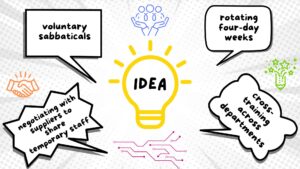Leading During Economic Uncertainty: Behavioural Tools for Turbulent Times

When storms sweep across the economy, leaders are often the ones holding the fort. The winds of inflation, supply chain disruptions, and unpredictable markets can make even the most confident teams feel unsteady. And yet, history shows that the greatest leaders are those who learned to guide their people through the storm itself.
One such story is that of Vikram Desai, the CEO of a mid-sized manufacturing company in Pune. In 2020, orders collapsed almost overnight. The phones in his office rang non-stop. Suppliers asking for payments, clients cancelling shipments, employees whispering about layoffs in the cafeteria. Vikram would sit at his desk late into the night, staring at spreadsheets that offered no clear answers.
Leadership in turbulent times is not about having all the answers. It is about the behaviours you practice daily, the emotional tone you set, and the rituals you create that allow people to keep moving forward with hope and focus. Vikram’s journey shows what that looks like in practice.
Containment over Control: A Foundation for Leadership in Turbulent Times
Vikram’s first instinct was to control everything – every purchase order, every shipment, every client call. But he could see the fear in his managers’ eyes. “If I keep clutching tighter,” he thought, “I’ll strangle what little energy we have left.”
So he did something different. He called his senior team into the conference room and told them plainly: “I cannot stop this storm. But I can make sure we do not face it alone. You have the freedom to act, and you have my support.”
One manager later said, “It felt like the ground under my feet steadied. We could breathe again.”
Communicating with Empathy: Stress-Aware Leadership in Action
Even with containment, tension simmered. Emails were short, meetings unusually quiet. Vikram noticed one engineer staring blankly at his screen for hours. Instead of pushing, he began every meeting with a simple check-in: “On a scale of 1–10, how are you holding up today?”
- People started opening up.
- One admitted he had not slept in three nights.
- Another confessed she was worried about paying her son’s school fees.
Vikram could not fix everything, but he listened. And in that listening, stress loosened its grip.
Expanding Choices: Decision-Making When Pressure Mounts
When the finance team proposed layoffs, the room went silent. Everyone assumed there was no other way. Vikram leaned forward and asked: “What else could we do? Let’s not stop at two options. Let’s list ten.”
 The ideas poured out: voluntary sabbaticals, rotating four-day weeks, cross-training across departments, even negotiating with suppliers to share temporary staff.
The ideas poured out: voluntary sabbaticals, rotating four-day weeks, cross-training across departments, even negotiating with suppliers to share temporary staff.
The whiteboard filled up. The mood shifted. Layoffs were no longer the only story—they had choices.
Building Collective Resilience: The Heart of Leadership During Crisis
 But choices alone did not erase fatigue. So Vikram introduced “Friday Reflections.” Teams gathered in the canteen at the end of the week, each sharing one stumble and one small win.
But choices alone did not erase fatigue. So Vikram introduced “Friday Reflections.” Teams gathered in the canteen at the end of the week, each sharing one stumble and one small win.
At first it felt awkward. Then came laughter as someone recounted a sales pitch that went spectacularly wrong. Applause followed when a junior clerk proudly announced she had prevented a costly dispatch error. Slowly, resilience became a shared practice. People began saying, “We are in this together.”
Training the Ambiguity Muscle for Adaptive Leadership
Still, uncertainty loomed. Vikram asked managers to run “future drills”—imagining best-case, worst-case and middle-case scenarios six months ahead. They scribbled on flip charts, debated wildly, even joked about outlandish possibilities.
It was messy, but it worked. When new disruptions came, people no longer froze. They had rehearsed uncertainty. Ambiguity was no longer a threat; it was a muscle they had trained.
Creating Meaning in Small Moments
 As the crisis dragged on, long-term goals felt hollow. So Vikram began focusing on the small things. A thank-you note to a supervisor who kept night-shift morale high. Public praise for a technician who fixed a broken machine against the odds.
As the crisis dragged on, long-term goals felt hollow. So Vikram began focusing on the small things. A thank-you note to a supervisor who kept night-shift morale high. Public praise for a technician who fixed a broken machine against the odds.
These tiny recognitions reminded people: “What I do matters.” Even when the big picture was blurred, the small moments gave clarity and purpose.
Feedback as an Anchor in the Storm
Vikram also redefined feedback. Gone were the formal appraisals. Instead, he sat down for “orientation talks.” He would say: “I know the delays are frustrating. Here’s why we made this call. And here’s where we go next.”
- Feedback stopped feeling like criticism.
- It became a compass.
- Employees walked out not heavier, but steadier.
Cultural Calibration: Leadership Across Emotional Economies
Vikram’s company also had teams in Dubai and Singapore. He realised that uncertainty did not feel the same everywhere. The Indian team leaned toward caution, while the Dubai group wanted bold moves.
Instead of forcing uniformity, Vikram adapted. In India, he reassured with safety nets. In Dubai, he set ambitious stretch goals. Each team felt seen and respected and that cultural sensitivity kept everyone moving in sync.
Behaviour as the True Test of Leadership During Economic Uncertainty
Months later, the storm had not fully passed, but the company was still standing. They had not only survived, they had grown closer, sharper and more adaptable.
Vikram reflected: “I never had a map. What I had were behaviours. That is what got us through.”
Conclusion
Economic storms will always come. Leaders cannot stop them, but they can choose how they show up within them. Vikram’s story is not about strategy or charisma. It is about behaviours: containment, empathy, choices, resilience, adaptability, meaning, feedback, and cultural calibration.
In the end, leadership during uncertainty is not about being the hero who holds all the answers. It is about being the human who steadies the team, listens with empathy, and shows them how to move together through the storm.
To know more about how The Yellow Spot can help you on your Learning journey, Visit ‘https://www.theyellowspot.com’ for more info or reach out at info@theyellowspot.com / India: +91 99677 14310, +91 87792 84314
#leadership skills # Crisis Leadership # Effective Communication # corporate training # best corporate training companies # Time Management # Ownership & Accountability #Emotional Intelligence #Pesonaleffectivenesstraining





